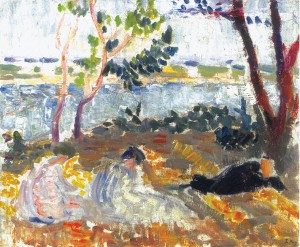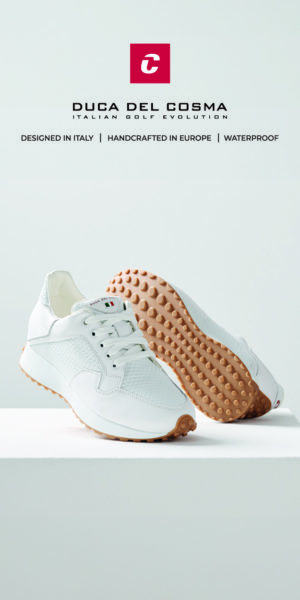Posted on March 29, 2016 in Arts & culture.
Plénitude d'un fauve - Jean Puy exhibition from April 9 to September 18, 2016
From April 9 to September 18, the castle museum of the Dukes of Württemberg in Montbéliard offers a retrospective of the work of Jean Puy (1876-1960), painter at the heart of artistic revolutions of the early twentieth century and present in his collections .
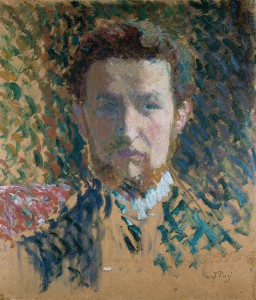
Self-portrait with beard, Jean Puy 1901
Oil on cardboard laid down on canvas, 46×39,5 cm
Jean-Jacques Bauswein Collection
© All rights reserved / ADAGP-Paris, 2016
Entitled Plénitude d'un fauve, the exhibition questions the itinerary of a work with multiple accents. After his beginnings marked by neo-impressionism and the determining experience of the fawn color, Jean Puy devotes himself to an intimate and figurative painting, approaching a form of tranquility. With more than a hundred works and documents deployed over 500 m2, this retrospective, the first in France since 2004 at the Marmottan Monet museum in Paris, brings a new look to this artist revealed by the eminent gallery owner Ambroise Vollard. Bringing together works from public collections that are rarely shown and drawing mainly on loans from private collectors, the exhibition takes on an unprecedented character.
Coming from a family of industrialists, Jean Puy studied at the École nationale supérieure des beaux-arts de Lyon and then in Paris at the Camillo Academy. In his early days, he rubbed shoulders with Matisse, Derain, Marquet, Camoin and Manguin, sharing workshops, models and reflections on the new painting. Revealed at the Salon d'Automne in 1905 which saw the appearance of the fawn movement, its landscapes, its nudes and its still lifes then set it up as a master at the age of 30. Lover of Brittany, he sails between Paris, Belle-Île-en-Mer, the Alps, but also the south of France, following in this the advice of his friends, before a final return to his hometown, Roanne. A lonely man, often in the shadow of famous friends, Jean Puy produced a prolific work over fifty years in his lifetime, enjoying international recognition.
An exhibition in five parts
Following a chronological route, the exhibition unfolds in five parts:
1/ The Neo-Impressionist beginnings (1900-1902)
The journey begins while Jean Puy is studying at the Camillo Academy under the aegis of Eugène Carrière. Through a shared passion for Belle-Île-en-Mer, he met Henri Matisse who had a great influence on his painting and remained his confidant. The first paintings of Jean Puy show a strong impregnation of the teaching of the divisionists, who recommend, instead of the classic mixture of tones, a juxtaposition of touches of pure color to access maximum brightness. From his friend Paul Signac, he does not only inherit this optical precept, he receives from his elder an initiation to yachting, essential for Jean Puy who has always wanted to become
marine.
2 / The fawn years (1902-1907)
The second part reports on this major episode in the history of art at the beginning of the 1905th century, which works on a synthesis of forms and the use of raw colors. Jean Puy exhibited in 1926 at the Salon d'Automne alongside Matisse, Manguin, Marquet and Camoin whose works caused a scandal. The room nicknamed the "Cage aux Fauves" by the critic Louis Vauxcelles later gave the name of fauvism to this current. It was also thanks to the Salon d'Automne that the decisive meeting took place with the gallery owner Ambroise Vollard, who gave Jean Puy international recognition and unfailing support until XNUMX.
3/ Harmony in the poetic equation (1908-1915)
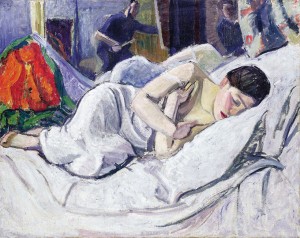
Sleeping Little Faun, Jean Puy c. 1906
Oil on canvas, 74,5 94,5 cm x
Paul Dini Collection, Lyon
© All rights reserved / ADAGP-Paris, 2016
After the fawn experience, Jean Puy moves away from the spatial and chromatic boldness which made him a modern artist. He abandons the immediacy of the subject to work on the composition. He therefore aims for balance and harmony, lingers on the interior and exterior decor, proceeds from collages, insists on the complex poses of the models, with a precise touch, almost acidulous colors, freezing the work in the time. Jean Puy spends his summers as close as possible to the landscapes of the Palais, Bénodet and Concarneau, trying in spite of himself to transpose "life on his canvas".
4/ After the war, a new wind (1919-1929)
Jean Puy voluntarily abandons his brushes during the First World War to go to the front. Upon his return, freeing his mood, Jean Puy devoted himself to the work of illustrator and caricaturist, in a new verve, following an order from his gallery owner Ambroise Vollard. He also produced a large series of ceramics. His more intimate painting leaves plenty of room for nudes, solitary readings by young women and interior scenes. His landscapes, from Doëlan to Toulon, figured in a certain lull, invite contemplation.
5/ The introspective workshop and the return to Roanne (until 1950)
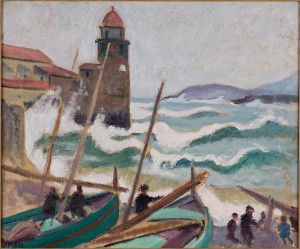
Storm in Collioure, Jean Puy 1913
Oil on canvas, 46 55 cm x
Private collection
© All rights reserved / ADAGP-Paris, 2016
At the start of the Second World War, Jean Puy took refuge with his sister Madeleine Vindrier, who owned a house in Roanne, in the heart of his hometown, where he stayed until the twilight of his life. If his career becomes more local, making himself a little forgotten in passing, Jean Puy makes his workshop the place of all possibilities, projecting in this closed universe his inner world, in an almost metaphysical way. The artist multiplies the self-portraits populated with ancient sculptures, has strange masks in front of the workshop window, stages dolls, giving the figures a timeless character, between disembodiment and eternal youth.
An exhibition catalog will be published on this occasion by the Montbéliard Museums. Reproducing sixty works present in the exhibition, it retraces Jean Puy's artistic journey from 1900 to the 50s. It is embellished with unpublished texts by Hervé Labrid, Marion Chatillon-Limouzi and Aurélie Voltz. (color ill., 96p., 15 €).
The exhibition will finally be complemented by a rich program of events spanning several months, including conferences and meetings:
- Wednesday May 11, 2016 at 18 p.m.: Meeting with the collector Paul Dini
- Wednesday June 15, 2016 at 18 p.m .: Round table with the Friends of Jean Puy
- Wednesday, September 23, 2016 at 18 p.m .: Conference by Damien Chantrenne, deputy director of the Paul-Dini museum, Villefranche-sur-Saône: "The artistic friendships of Jean Puy"
Works by Jean Puy in the Montbéliard collection
In 1969, Jacqueline Bret-André donated her father Albert André's works to the National Museums, deposited in the castle museum of the Dukes of Württemberg in memory of her childhood spent in the Pays de Montbéliard. Twenty paintings by friends of Albert André are on display, including seven works by Jean Puy.
The Castle Museum of the Dukes of Württemberg
Located in the heart of the city of Montbéliard, the castle of the Dukes of Württemberg stands on a rocky spur overlooking the confluence of the Lizaine and the Allan. Consisting of two large round towers (1424 and 1590) and a main body rebuilt in 1751, the castle was for four centuries, from 1397 to 1793, the residence of the Dukes of Württemberg who marked the Land of Montbéliard with independence from spirit and freedom which was reinforced in the 1960th century with the Lutheran reform. In 1970, the castle became a museum gathering diverse and rich collections: archeology, natural history and fine arts. Since 600.000, the museum has also developed a collection of contemporary art. The collection of the Museums of Montbéliard currently has XNUMX pieces.
Castle Museum of the Dukes of Württemberg
25200 Montbeliard
03 81 99 22 61
museums@montbeliard.com
www.montbeliard.fr
Exhibition from April 9 to September 18, 2016
10 a.m. to 12 p.m. and 14 p.m. to 18 p.m.
Closed Tuesday and May 1
Entrance : 5 euros / Group and student rate: 3 euros
Free entry for children under 18, disabled people, as well as the 1st Sunday of each month.
Opening April 8 at 18 p.m.
Curator of the exhibition: Aurélie Voltz, director of the Museums of Montbéliard, assisted by Bertille Favre.
Drawing Now Art Fair: Tatiana Wolska winner 2024
The invention of language by Gertrude Stein and Pablo Picasso
The history of French women's golf at Golf du Sorbier






